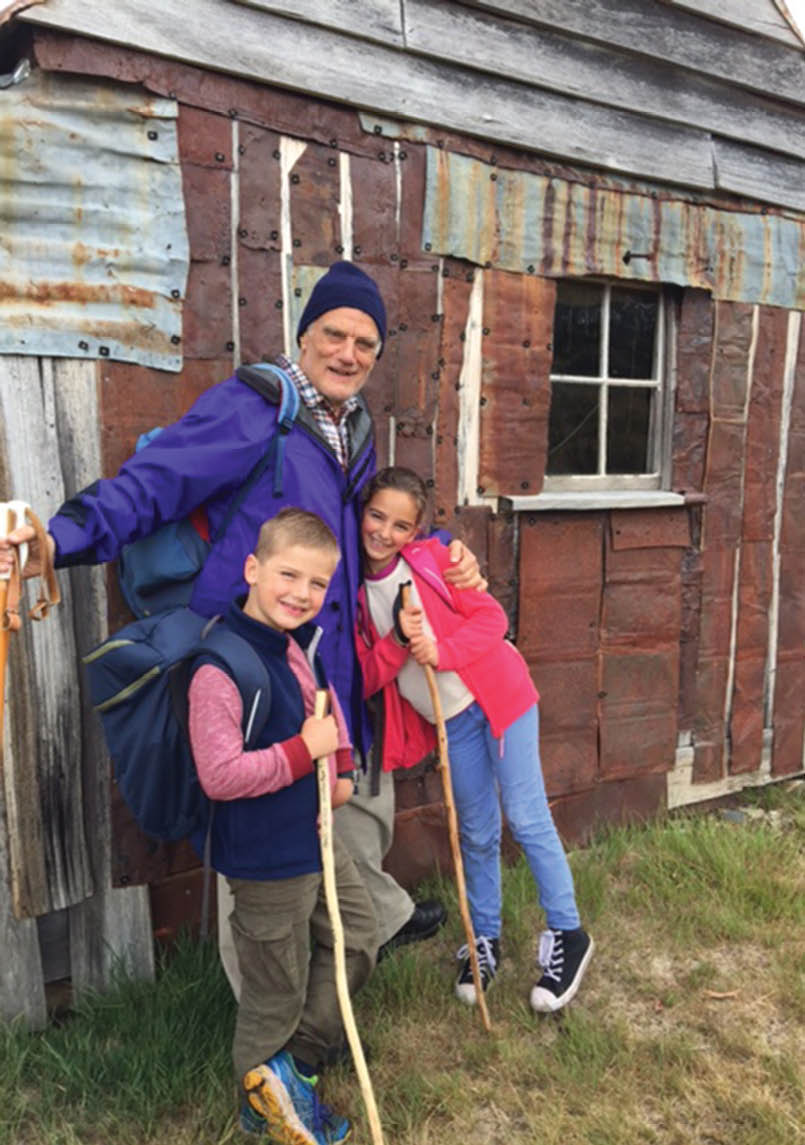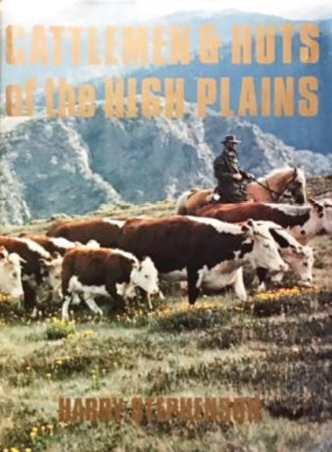



One of the challenging suggestions to come out of a little known international publication called Les Alpes australiennes (The Australian Alps, 1992) is an inventory of alpine literature. The editors, Roger Good and Philippe Grenier, proposed headings such as accounts of exploration, personal experiences, studies of tradition and folklore, picture books and travel guides.
Klaus with Ben and Zoe at the historic Four Mile Hut with its ornate metal decorations in 2017 Abi Curtis
Our High Country Lore and Literature – 1880s to 2010s
Klaus Hueneke

54 | BWA February 2019



This overview is facilitated by the many books it's been my pleasure to collect and dip into over the last 50 years. Some 300 titles or about five metres, all in some way related to the Australian Alps, now sit in roughly alphabetical order on my bookshelves. I won't be as systematic or as academic as the editors suggest but will range widely and mention some of the most representative and interesting. Readers will no doubt have favourites of their own.
Aborigines and explorers The Aborigines didn't leave us any bound volumes, at least not in the usual form, but their activities were recorded by the likes of Hume & Hovell, Howitt, Lhotsky, McMillan and Strzelecki. Hamilton Hume, William Hovell and entourage were the first white people to spy the snow covered Snowy Mountains back in 1824. The historic journey, and the one you can do now, was engagingly written up by Harry Hill in 1993. The track covering some 300 kilometres between Wee Jasper and Woomargama in New South Wales, can be done as walks of a day, a weekend, a week, or as long as a month.
Alfred Howitt was a keen observer of Aboriginal life, language and customs and made many journeys into and across the
mountains. His biography Come Wind Come Weather was written by Mary Howitt Walker. John Lhotsky came through the Monaro and got as far as a hill south of Thredbo. His A Journey from Sydney to the Australian Alps was edited by Alan Andrews and published by Blubberhead Press in 1979.
One of the books about Angus McMillan is Kenneth Cox's Pathfinder (1973). McMillan traversed large parts of Gippsland and the foothills of the Victorian Alps. Count Paul Edmund Strzelecki was active about the same time. He and James McArthur climbed the Kosciuszko Main Range from the Geehi valley in 1840 and then went on to Melbourne via Gippsland. They had Aboriginal guides for at least part of the journey.
The number of books and articles about Strzelecki's life, including whether or not he climbed Mt Kosciuszko, is legion. They include The Count by Geoffrey Rawson (1953), In a Dark Glass by Helen Heney (1961) and Kosciusko - the Mountain in History by Alan Andrews (1991). The latter is perhaps the most even-handed. It is still in print.
Research into the life and times of the Aborigines has generated many theses, reports and papers but very few books for
Klaus with daughter Abi near Mount Tabletop, KNP, in 2017Mark Curtis
The loreIt's more heart than intellect,it's both knowledge and wisdom,it builds instead of pulling down,it whispers rather than shouts,it's more humble than haughty,it embraces nature instead of fighting it,it respects those who have gone before and inspires those who are growing now,in short, it's quite like the "Songlines" that have flourished here for thousands of years.
BWA February 2019 | 55
public consumption. Josephine Flood's The Moth Hunters (1980) was a great beginning. I can still taste the nutty flavour of roasted Bogong moths served with Jatz biscuits at the launch. It is out of print except for some parts which were published as Moth Hunters of the ACT in 1996. Some of her assumptions have been challenged in a thesis The myth hunters by Alistair Grinbergs, but where is the book? Another person to counter earlier beliefs is Peter Gardner. His Gippsland Massacres (1993), in revealing many sordid details of the way Europeans really dealt with Aborigines, trod on many establishment toes. Up at Kosciuszko, Michael Young’s The Aboriginal People of the Monaro (2000 and revised in 2006) has done much to counter the belief that there are no descendants of high country Aboriginals. Some of them have now helped John Blay write On Track – Searching out the Bundian Way (2015). It is one possible walking route used 200 years ago between Kosciuszko and Eden.
The colonists Squatters, miners and cattlemen followed the first white explorers. They rarely put pen to paper but left enough evidence for others to trace their movements. The life of Murray of Yarralumla, who took stock into the northern plains of the Kosciuszko area in the 1840s, was meticulously researched by Gwendoline Wilson. My Tabletop Press printed a revised version in 2001. It is still in print. The Pendergasts and O'Rourke's rode into the Omeo area about the same time. Their journeys and those of many others were collected, edited and bound into a best seller Cattlemen & Huts of the High Plains by Harry Stephenson in 1980. Harry was one of the first to tap into the rich lode of high country lore.
One of the most vivid descriptions of life in a high country mining town is by George Ogilvy Preshaw in Banking Under Difficulties. He lived in Kiandra in 1860 but the book wasn't produced until 1888. To get to Kiandra he had to endure a seven day ride on the back of an uncooperative horse, and when he did, he had to shake down in a small room with six others. The bank, at which he was a teller, was made of calico and had a stream running through it.
Scientists and others The men intent on making a living from grazing were followed by artists, surveyors, botanists and scientists. They were well educated, articulate and often interested in self-promotion. Ferdinand von Mueller became one of the most famous. He wrote thousands of letters, as well as books, learned papers, treatises, pamphlets and lectures. An in depth and well written character study is Edward Kynaston's A Man on Edge (1981). The title says it all.
A latter day equivalent to Von Mueller, at least in terms of output, is Alec Costin. Author of numerous papers he is also responsible for a weighty tome on the ecosystems of the Monaro (including the high country) and in conjunction with Wimbush, Totterdell and Gray wrote Kosciuszko Alpine Flora (1979). This exhaustive much acclaimed work was reprinted by CSIRO a few years ago with new colour plates and some revisions. It is still in print as a paperback. Three of the four authors have passed on but Alec Costin is still active especially on the controversial brumby culling issue.

Cattlemen & Huts of the High Plains
56 | BWA February 2019
The only substantial book on the unique flora of the alps before Costin and others burst into print was Thistle Harris' Alpine Plants of Australia (1970). A popular and more general text is Leon Costerman's bible Native Trees and Shrubs of South-East Australia (1981). Many others have filled in various gaps including members of Friends of Grasslands (ACT) with Grassland Flora of Southern Tablelands and Woodland Flora – Field Guide for Southern Tablelands. Still in print, they include species found in the high alps. In Victoria, John Murphy and Bill Dowling produced Plants of the Victorian High Country in 2010.
On the animal front, the best volume is still Wildlife of the Australian Snow Country (1994). The authors, Ken Green and Will Osborne, started their snow country research as undergraduate students at the University of Canberra in the 1970s. I visited Ken with a group of adult students at his tree line camp below the Ramshead in 1981. The pipe-smoking author was monitoring native rats, and in winter sometimes had to dig down three metres to get to the traps. Later on he formed a high country scientific research collective.
About 30 years ago the scientific community pooled its knowledge and published two collections of papers. The Scientific Significance of the Australian Alps came out in 1988 and the French volume alluded to at the beginning of this article a few years later. It is quite an honour for an European research institute to pay our mountains so much attention given that they are not very dramatic or terribly high. Geoff Mosley's dream, enunciated in that volume, of them becoming a World Heritage Area is still not a reality. The cultural side of things was not neglected. A popular symposium in 1991 resulted in the 357 page Cultural Heritage of the Australian Alps.
Exploration, conservation and history Books of exploration, history and folklore include Harry Stephenson's Skiing the High Plains (1982), George Seddon's Searching for the Snowy – An Environmental History (1994), Matthew Higgins Skis on the Brindabellas (1994), the highly influential The Alps at the Crossroads by Dick Johnson (1974), and
Niall Brennan's Tales from the Australian Mountains (1979). Wally Mortimer has written two books on the history of Wonnangatta Station and Professor Keith Hancock wrote Discovering Monaro - a Study of Man's Impact on his Environment way back in 1972.
Of these books, Dick Johnson's is something of a classic especially now that the Alpine National Park, for which he and many conservationists fought so valiantly, has become a reality. Niall Brennan's book includes an enlightening chapter about the error prone Gadsden tragedy on Mt Bogong. Keith Hancock's volume is the best-known in academic circles. Most of these titles are now only available second hand or in libraries.
Tor Holth and I started photographing, interviewing and writing about the same time. It was in the mid-70s when little was known about our rustic mountain huts, the grazing era and the lore of the high country. His Cattlemen of the High Country appeared in 1980 and his Challenge of the High Country, written in conjunction with his wife Jane, in 1985. My Huts of the High Country, with

The Alps at the Crossroads
BWA February 2019 | 57


Klaus on the Cobberas in 2000 at the beginning of a walk to Dead Horse Gap Graham Scully
seven reprintings, has become a classic and is still selling 37 years hence. It was joined by Kiandra to Kosciusko in 1987, People of the Australian High Country in 1994 and in 2003 by Huts in the Victorian Alps. I wrote about the south coast of NSW for a while before coming back to the mountains with Charlie Carter – Hermit, Healer and High Country Legend (2017).
Personal memoirs Many books based on personal experience have come from dingo trappers, bushwalkers, skiers and naturalists. Clyde Sykes wrote about his dingo chasing days in A Man from Gelantipy (1982) and Paddy Pallin, after a lifetime of making, using and mending outdoor gear put together his recollections as Never Truly Lost (1987). John Landy, the great runner of the 1950s, metamorphosed into a caring naturalist in the 80s and in his Close to Nature (1985) gave us a gem of nature writing. Detailed observations of insects and fungi are complemented by serene early morning photos taken in the foothills of the Kosciuszko area on the Murray side.
One of the mountain legends was Mick Hull. He was a mate of Cleve Cole, and was with him when he died in 1936. His Mountain Memories - Sixty Years of Skiing (1990) was put together with the help of Harry Stephenson. It's a 420-page epic with lots of photos. Post war migrants have also put pen to paper. Ernest Forras, who had a lot to do with early ski developments at Mount Buller, wrote Earnest Escapades (1994) and Tony Sponar, who chose the site of Thredbo, wrote Snow in Australia - That's News to Me (1995). In 2013, Gillian Salmon produced The King of Hotham – My Father. These titles are part of a recent avalanche of books about the history of downhill skiing and the ski resorts. There are at least six about Thredbo and some of its legendary personalities. Numbering in the dozens, they deserve a separate overview.
Most of their authors were pro-development whereas Ian Stapleton was against it. Ian, after being the outdoor education teacher at Timbertop for some years, built Wollangarra and Mittagundi, two bush camps for teenagers on the McAllister River and the Mitta Mitta. To help pay for the building costs
58 | BWA February 2019

Neil Wilson ski touring at Crooks Racecourse in 1984
he wrote books about the experience and sold them at well attended public gatherings. In time he also had a trailer load of historic photos, interviews and papers. From his home at Harrietville these are now turning into a four or five volume history of the Victorian high plains. Catchy titles include Hairy chested history and From Drovers to Daisy-Pickers (2006).
Skiing Most of the early accounts of ski exploration are in the Australian Ski Year Book. They include trips to the Main Range, winter crossings from Kiandra to Kosciuszko and journeys across the Bogong High Plains. First published in 1928, the early editions constitute the bulk of recorded skiing history. They are also quite rare, even the National Library doesn't have a complete set.
Elyne and Tom Mitchell feature in some of the early editions and so does Alan Andrews, for whom I have published four books: Kosciusko – the Mountain in History, Skiing the Western Faces - Kosciusko, Earliest Monaro and Rainforest and Ravished Snow. Few would know the gullies, chutes and funnels of the western faces better than Alan. He started skiing them in the 1950s and was still having a go in his mid-70s.
Fiction and poetry Much of Alan's inspiration, both in his writing and skiing, came from Elyne Mitchell. Her Australia's Alps (1942) is still the most poetic and romantic evocation of being in, and seeing and feeling the high country in winter. It's also a good, if sometimes flowery, piece of nature writing. She was one of our most prolific authors, having produced The Snowy Mountains (with Mike James in 1980), Discoverers of the Snowy Mountains (1985) and the evergreen multi-volume Silver Brumby Series. In 2001 Alison Lester added to the mystique and romance of wild high country horses with The Snow Pony. She has not been the only one.
Many of Elyne’s poems appeared in A Vision of the Snowy Mountains. Other poets of note include Banjo Paterson, Douglas Stewart, David Campbell, Mark O’Connor, Don Kneebone, Neil Hulm and Ted Winter. Mark O’Connor’s poems appeared in Tilting at Snowgums and Ted Winter’s in Mountain Verse as well as my Huts of the High Country. Lesser known but just as important are small volumes with dramatic titles like If That Man Comes Here, I’ll Shoot Him by Rosemary Curry. It features poems from Gladys Weston and Emily McGufficke, the daughters of a stockman. Lots of poems, in traditional ballad style, have appeared in Voice of the Mountains the Journal of the Mountain Cattlemen's Association of Victoria and in other places. The Banjo's work continues to be popular, especially when there is an anniversary, a film or another reworking of his life and times.
Banjo’s The Man from Snowy River, illustrated by MacArthur-Onslow, is the best seller amongst books for children. It is closely followed by Diary of a Wombat, Baby Wombats Week and Wombat Goes to School, all by Jacky French. Many authors have been fascinated by wombats including Ruth Park with The Muddleheaded Wombat and Susanna Chambers with The Snow Wombat. I am sure there will be more.
Novels that come to mind include Miles Franklin's Childhood at Brindabella, Eleanor Stoddard’s When the Mountains Change Their Tune (1985), Niall Brennan's Man Upon His Mountain (1984), Hugh Capel’s Where
BWA February 2019 | 59


the Dead Men Lie (2002) and most recently Matthew Higgins's Seeing through Snow (2017). It is centred round life in Kiandra many years ago. Brennan's book is loosely based on the infamous Wonnangatta murders. Some people believe, that as a society, we have only become at one with our environment when we have been able to fictionalise it. This list suggests we are well on the way.
The Snowy mountains schemeIn terms of output nothing quite matches the number of books about the Snowy Mountains Scheme. It has been documented in encyclopaedic fashion including Lionel Wigmore’s Struggle for the Snowy (1968), Noel Gough’s Mud, Sweat and Snow (1994), Siobhan McHugh’s People behind the Power and Brad Collis’ Snowy – The Making of Modern Australia, still in print. Deirdre Slattery in her Australian Alps – Kosciuszko, Alpine and Namadgi (1998) is, as far as I know, the only one to also cover the Kiewa Scheme in Victoria. It is the most comprehensive book on all three alpine national parks.
Photographers Photographers have been inspired by the grandeur, uniqueness and special light of the alps since before the turn of the century. Charles Kerry took his plate glass camera to the Kiandra Snow-Shoe Carnival in the 1890s and Nicholas Caire was at Mt Buffalo in 1900. As camera technology improved and as more and more people took to the hills, the number of books grew.
Landmark volumes include The Call of the Mountains (1952) by Colin Wyatt, The High Country (1967) by Helmut Gritscher, Range Upon Range (1987) by Harry Nankin, Banjo Paterson's High Country (1989) by Trisha Dixon and my own Kosciuszko – Where the Ice-Trees Burn (1990). Harry Nankin's is the Porsche of photographic books, closely followed by Colin Wyatt's. One is in exquisite colour and the other in grainy black and white. Wyatt's covers most of the alps of the world and may have been one of the first international books to include photos of our own snow-covered hills.
Showing my collection of historic black and white photos from the high country. Now at the National Alpine Museum of Australia who have digitised it.
60 | BWA February 2019


Guide books A recent increase in the number of bushwalkers and skiers has led to more guidebooks, and more guidebooks has led to more people in the bush. The first and for many years the only guide was Snowy Mountain Walks compiled by the Cooma based Geehi Club. Next came a number of Algona guides including The Alpine Track, Mount Buffalo National Park, Bogong National Park and Ski Touring in Australia. When John Brownlie sold Algona, John Siseman and John Chapman continued his work and produced The Australian Alps Walking Track as well as a number of others.
Others who have sought to show us how to get to and enjoy dramatic places in the alps include Charles Warner and his Bushwalking in Kosciuszko National Park (1983), Philip Ingamells with Discovering Mount Buffalo (2001), Ian Fraser and Margaret McJannett with Above the Cotter (1991), the many works of Graeme Barrow such as Namadgi & Tidbinbilla Classics (2000) and Bold Horizon by Matthew Higgins (2018).
Final notes So there you have it according to my collection of books and personal biases. The above represents the bulk of books written but does not include all the reports and musings in club journals, newspapers, magazines and conference proceedings. The output of books on the high country is obviously rich and diverse, perhaps more so than for any other part of Australia. There are indications that this will grow in depth and strength as new generations become inspired and add their observations. I hope there will be some epic novels and gripping pieces of nature writing amongst them.
Some of the books I have published or written on the high country. And a couple of calendars.
Klaus Hueneke, OA-AM, is the author and/or publisher of about twenty books set in the high country. His company Tabletop Press has been distributing books about the mountains to regional bookshops since 1987. He can be found at khueneke@bigpond.com.au or the web site Tabletoppressbooks.com.

BWA February 2019 | 61